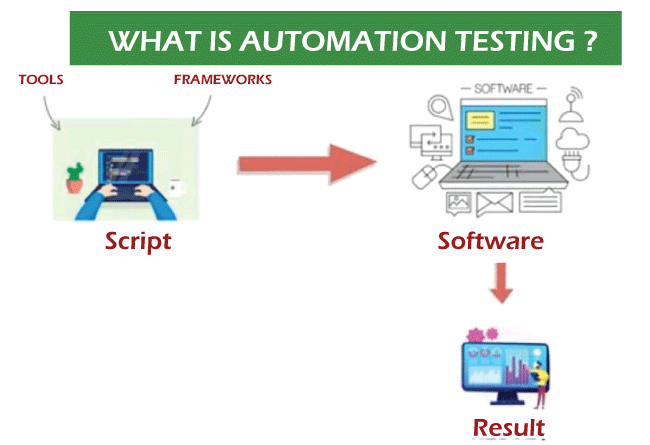The Best Guide to Implementing Automation Testing Successfully
Wiki Article
From Guidebook to Automated Testing: A Comprehensive Guide to Transitioning Efficiently and Efficiently
In the world of software application testing, the change from handbook to automated procedures has actually ended up being an increasingly important shift for organizations seeking to enhance effectiveness and precision in their screening techniques. As modern technology remains to advance, the requirement for smooth and reliable automatic screening approaches has actually never ever been a lot more important. The journey from handbook to automated screening is not without its obstacles, but when come close to tactically and with a clear strategy in mind, the advantages can be significant - automation testing. In this comprehensive guide, we will discover key steps and considerations crucial for an effective change, from the preliminary choice of tools to the combination of automation into existing workflows. Keep tuned to reveal the insights that will assist lead the way for a smoother and extra reliable testing procedure.Benefits of Automated Checking
Automated screening offers various benefits, boosting effectiveness and precision in software program development processes. Automated examinations can be run at the same time on numerous devices and running systems, significantly speeding up the screening stage contrasted to hands-on screening.Moreover, automated testing makes sure a greater level of precision in discovering issues. Since automated examinations adhere to predefined scripts, human mistake is decreased, bring about more trusted test results. Consistency in testing is likewise boosted, as automated tests perform the exact same actions specifically each time they are run. This consistency is vital in guaranteeing that all functionalities of the software program are thoroughly examined, reducing the chance of undiscovered bugs slipping through to production.
Choosing the Right Tools

To start with, evaluate your demands and objectives. Recognize the extent of your task, the modern technologies included, and the skill set of your team. This analysis will certainly aid you establish the capacities and functions you need in your testing tools.
Second of all, take into consideration the compatibility of the devices with your existing processes and systems. Seamless integration with your existing software program advancement lifecycle is essential to ensure a smooth change to automation.
In addition, assess the scalability and flexibility of the devices. As your testing needs advance, the devices ought to be able to adjust and fit modifications efficiently.
Last but not least, variable in the assistance and neighborhood around the devices. When implementing automated screening, robust assistance and an active user area can provide valuable sources and support. By thoroughly considering these aspects, you can pick the right tools that align with your needs and established the stage for a successful shift to automated screening.
Composing Reliable Test Manuscripts

When crafting test manuscripts, it is necessary to think about the particular requirements of the software program being evaluated and make certain that the scripts resolve all vital functionalities. Clear and detailed calling conventions for test manuscripts and test instances can enhance readability and maintainability. Furthermore, incorporating error handling devices within the test manuscripts can help in determining and addressing concerns promptly.
Moreover, organizing test manuscripts into modular parts can improve reusability and scalability, minimizing redundancy and enhancing effectiveness in test manuscript maintenance. Routine testimonials and updates to evaluate manuscripts are essential to maintain pace with advancing software application needs and functionalities. By complying with these concepts, testers can create durable and reliable test scripts that add considerably to the success of automated screening processes.
Integrating Automation Into Workflows
Reliable assimilation of automation tools into existing workflows enhances procedures and enhances efficiency within software program advancement cycles. When including automation into process, it is crucial to determine recurring jobs that can be automated to conserve time and reduce human error. By seamlessly integrating automated testing tools like Selenium or Appium into the software development lifecycle, groups can accomplish faster responses on code changes, leading to quicker insect detection and resolution. This assimilation enables for constant testing throughout the development procedure, making sure that any kind of issues are recognized beforehand, leading to higher software application top quality. Furthermore, automation can be utilized to activate examinations immediately after each code dedicate, offering immediate recognition and releasing up testers to concentrate on more facility situations. Proper assimilation of automation tools calls for partnership between growth, testing, and procedures teams to establish a unified process that optimizes performance and efficiency in supplying high-quality software.Making Sure a Smooth Change
Successfully transitioning to automated screening entails precise preparation and careful execution to maximize and reduce disturbances performance in the software advancement procedure - automation testing. To ensure a smooth shift, it is vital to start by conducting a complete analysis of the existing testing processes and determining locations where automation can bring one of the most substantial benefits. Involving with all stakeholders beforehand while doing so, including developers, testers, and job supervisors, is vital for amassing support and buy-in for the automation initiativeCommunication is essential during this transition phase. Clear communication of the goals, benefits, and expectations of automated testing helps to handle any type of resistance or worries that may develop. Furthermore, giving adequate training and resources for staff member to upskill in automation tools and techniques is vital for guaranteeing a successful transition.
check that

Conclusion
In conclusion, transitioning from handbook to automated testing uses many advantages, consisting of raised performance and integrity. By picking the appropriate devices, writing effective test scripts, and integrating automation seamlessly right into operations, organizations can ensure a smooth and successful transition. It is vital to embrace automation as a valuable asset in software screening procedures to enhance general quality and productivity.In the world of software program testing, the shift from manual to automated processes has actually come to be a progressively crucial shift for organizations looking for to boost effectiveness and accuracy in their screening techniques. Automated tests can be run at the same time on multiple tools and running systems, dramatically speeding up the screening phase contrasted to hand-operated screening. Uniformity in screening is additionally enhanced, as automated examinations implement the exact same steps specifically each time they are run.To make sure the successful execution of chosen screening tools, the creation of reliable test manuscripts plays an important role in confirming the functionality and efficiency of automated processes - automation go to this web-site testing. By adhering to these principles, testers can develop effective and durable test manuscripts that add substantially to the success of automated testing processes
Report this wiki page